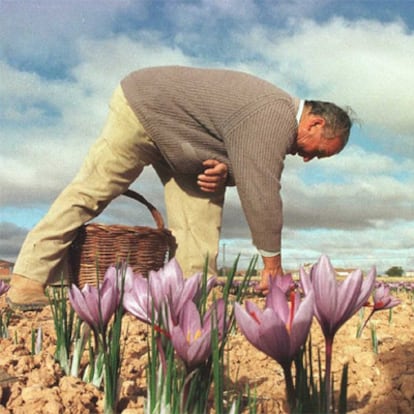Made in Spain? The great saffron trading scandal
La Mancha farmers' products undermined by shoddy imports
It has an intense smell and is sold by the thread. Saffron is the red gold of the parched La Mancha region and it does not come cheap. Saffron harvested here costs about 3,000 euros per kilogram. Spain exported 190,000 kilos in 2010, yet local production amounted to just 1,500 kilos. Dubious growing practices and labeling anomalies are behind this giant mismatch.
Up to 90 percent of exports are fraudulent, according to farmers union ASAJA. "It's shameful the prices they sell it at, even more so when they know it's crap," said one exporter, who asked to remain anonymous.
It takes 250,000 saffron crocus blooms to make a kilo of the fragrant spice from the flowers' stigmas, the tiny filaments that collect pollen. This profitable industry netted ?47 million last year but saffron growing is costly- or at least it should be.
Among growers it's an open secret that adulterated saffron is widely sold
But where does all this other saffron come from? Part of the explanation lies in imports. Spanish companies can sell saffron bought from other countries such as Iran, Morocco and Greece, as Spanish. This is misleading for the consumer but not technically illegal under Spanish law.
Iranian saffron is nearly half the price of the Spanish crop, according to Antonio García from La Mancha's labeling authority. But he says intensive production methods make for a low-quality product that undermines La Mancha's own brand. Several Iranian companies have also set up in Spain to take advantage of these lax labeling rules.
The Industry Ministry is considering a new regulation that would oblige growers to state the country where the saffron was grown. This would bring Spain into line with the guidelines of the International Organization of Standardization. However although this would protect consumers, it would go against the interests of large export firms. The Spanish label is prestigious but local production cannot come close to satisfying demand. Only 0.8 percent of the "Spanish" spice sold last year was grown in La Mancha.
But imports alone cannot explain the 2010 production-export discrepancies. Among growers it's an open secret that adulterated saffron is widely sold. A recent report in British newspaper The Independent found that between 40 and 90 percent of Spanish saffron was made up of other residues of the plant- not the stigma. A sample proffered by regulator García is in fact cardamom, another spice altogether. How can you tell the difference? According to García, false saffron smells unpleasant. The real thing takes a long time to dye food an intense yellow, and bears the official La Mancha-grown saffron label.
The Industry Ministry says it has not seen the analyses cited, and can hide behind the fact that internal EU imports are not subjected to tests. Francisco Martínez Arroyo, director of La Mancha Farming and Livestock council, says inspections do take place. He acknowledges attempts to commit fraud, but "not in La Mancha." (The regions that export most are Valencia and Murcia, where saffron is not grown.)
José María Fresneda from ASAJA is more direct. "Fraud has been going on for years," he says. His union proposes tariffs or quotas to deter malpractice. The most important thing, he says, is to protect farmers who "grow the kind of saffron that makes paella to die for."

Tu suscripción se está usando en otro dispositivo
¿Quieres añadir otro usuario a tu suscripción?
Si continúas leyendo en este dispositivo, no se podrá leer en el otro.
FlechaTu suscripción se está usando en otro dispositivo y solo puedes acceder a EL PAÍS desde un dispositivo a la vez.
Si quieres compartir tu cuenta, cambia tu suscripción a la modalidad Premium, así podrás añadir otro usuario. Cada uno accederá con su propia cuenta de email, lo que os permitirá personalizar vuestra experiencia en EL PAÍS.
¿Tienes una suscripción de empresa? Accede aquí para contratar más cuentas.
En el caso de no saber quién está usando tu cuenta, te recomendamos cambiar tu contraseña aquí.
Si decides continuar compartiendo tu cuenta, este mensaje se mostrará en tu dispositivo y en el de la otra persona que está usando tu cuenta de forma indefinida, afectando a tu experiencia de lectura. Puedes consultar aquí los términos y condiciones de la suscripción digital.
Últimas noticias
The complicated life of Francesca Albanese: A rising figure in Italy but barred from every bank by Trump’s sanctions
From digital curfews to blocking apps: How technology experts protect their children online
Why the price of coffee has skyrocketed: from Brazilian plantations to specialty coffee houses
Confined to a Cuban hospital: When electricity is a matter of life or death
Most viewed
- Pablo Escobar’s hippos: A serious environmental problem, 40 years on
- Why we lost the habit of sleeping in two segments and how that changed our sense of time
- Trump’s obsession with putting his name on everything is unprecedented in the United States
- The Florida Keys tourist paradise is besieged by immigration agents: ‘We’ve never seen anything like this’
- Charles Dubouloz, mountaineering star, retires at 36 with a farewell tour inspired by Walter Bonatti








































